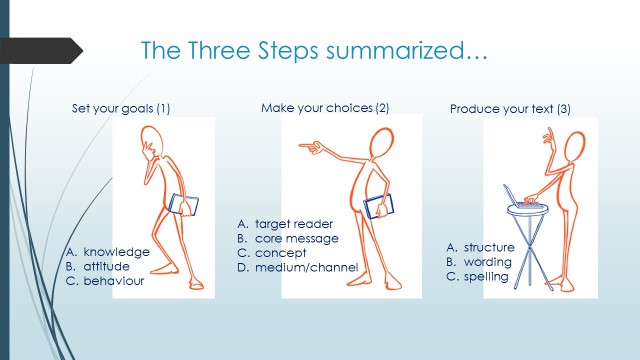STEP 1, setting your goals, and STEP 2, making your choices, together support you preparing a text. Use the TPF to make your choices accurately.
Only after being completely satisfied with STEP 1 and STEP 2, you should start producing the text in STEP 3.
The meaning of the 10 specific elements in these three steps will be thoroughly explained to you in the e-book Text Strategy. In the e-book you’ll find an elaborate example and discover how a text appears ‘almost automatically’ by following the steps precisely. On this page you’ll find a summary.
More about the e-book
STEP 1: set your goals
STEP 1A, knowlegde goal
STEP 1A is about your KNOWLEDGE GOAL: what would you like your reader to know after reading your text? Here you simply list all the facts relevant for the situation. Be specific.
STEP 1B, attitude goal
In STEP 1B you decide on your ATTITUDE GOAL: what should your reader think or feel after reading your text? Which emotion is most relevant in order to reach the BEHAVIOUR GOAL in STEP 1C?
STEP 1C, behaviour goal
What would you like your reader to do – or maybe not do – immediately after reading the text?

STEP 2: document your choices
STEP 2A, Target reader
Who will read your text? To create a profile, a precise description of the person you have in mind, answer the four ‘writers’ questions’: what does he know, feel, want, and what is he able to understand?
STEP 2B, Core message
Summarize your message in no more than 30 words. What should your reader remember after he has finished reading? What would you like him to tell others about your text or presentation?
STEP 2C, Concept or creative hook
What is the creative hook to empower the core message? Which idea will strengthen your words?
STEP 2D, Medium & channel
Which medium and channel will be used to convey the message to your reader?
STEP 3: produce your text
STEP 3A, Structure
Formulate the readers’ questions and put those questions into a logical order. Readers’ questions are the ones that are in your reader’s mind when he is confronted with your text.
STEP 3B, Final product: text
If you know which questions you want to answer (3A), you can now simply produce your text by answering them. It really is that simple. The text will appear almost automatically.
Conclusion
Discuss the choices, not the words and the sentences!
Writing is not comparable to mathematics. The result, the final product, will differ by person. The choices a writer has made in the text preparation (STEP 1 and 2) directly influence the words he uses to produce the text. So, if there is a discussion about a text it should concern the choices, not the words. This emphasizes the necessity of the focus on product specifications before you start producing the words.
The digital tool TPF, Text Preparation Form, makes is easy for you to apply the method for Text Strategy. You can use the TPF for producing a new text, but also the other way around, for rewriting a text that doesn’t match your goals anymore.

